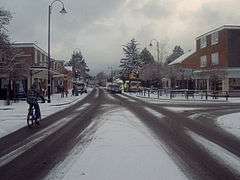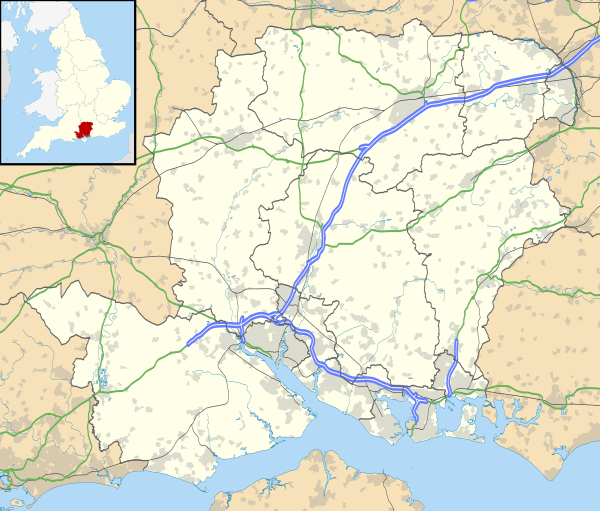Dibden Purlieu
Dibden Purlieu (/ˌdɪbdɛn ˈpɜːrliuː/) is a village situated on the edge of the New Forest in Hampshire, England. The village merges with the nearby town of Hythe. It is in the civil parish of Hythe and Dibden.
| Dibden Purlieu | |
|---|---|
 Dibden Purlieu village centre following snowfall | |
 Dibden Purlieu Location within Hampshire | |
| OS grid reference | SU412061 |
| Civil parish |
|
| District |
|
| Shire county | |
| Region | |
| Country | England |
| Sovereign state | United Kingdom |
| Post town | SOUTHAMPTON |
| Postcode district | SO45 |
| Dialling code | 023[1] |
| Police | Hampshire |
| Fire | Hampshire |
| Ambulance | South Central |
| UK Parliament | |
The approximate population is around 4000 people. The regular Blue Star bus service provides Purlieu's quickest link with the city of Southampton. Dibden Purlieu is twinned with Mauves-sur-Loire, France.
History
Dibden Purlieu was in the parish of Dibden, referred to in the Domesday Book of 1086 as Deepdene, "dene" being an Anglo-Saxon word for valley.[2] Purlieu is a Norman-French word meaning "the outskirts of a forest" – a place free from forest laws. In this particular case Dibden Purlieu was land removed from the New Forest in the 14th century when the forest boundaries were established by perambulations about 1300.[3] In practice the king retained or claimed, certain rights in the area, and the activities of the royal foresters in enforcing forest law there were a matter of great resentment.[3] Up to the 1950s Dibden Purlieu was a small settlement next to the village of Dibden, but the expansion of Fawley Refinery lead to a demand for more houses for workers, and Hythe and Dibden Purlieu were allowed to expand into a small town.[4] In 1983 the parish was renamed, and Dibden Purlieu is now part of the parish of Hythe and Dibden.[5]
Notable residents
Richard Eurich RA OBE was the war artist to the Admiralty from 1941.
Ron Lane was a wood sculptor of wildlife.[6]
Schools
Dibden Purlieu has two large secondary schools; Noadswood School and Applemore College. Totton College also has a small campus in the village specialising in adult education services.
Primary education is now provided at several schools in the village. Wildground, was the first in Armitage Avenue. The junior school opened on this site in 1962, with the infants' premises following two years later. Prior to that, the school had occupied temporary accommodation in Lunedale Road, which later included use of the adjacent Women's Institute Hall. The village had further primary's schools added with the opening in the late 60s of the separate Orchard Infant and Orchard Junior schools on Water Lane, adjacent to Noadswood School.
References
- "Telecoms numbering". ofcom.org.uk. 28 April 2010.
- Dibden, Old Hampshire Gazetteer
- Dibden Purlieu, Old Hampshire Gazetteer
- Journal of the Town Planning Institute, (1953), Volume 39, page 87: "At Fawley the construction of Europe's largest oil refinery on Southampton Water has created a demand for more housing accommodation and it is proposed to satisfy this by expanding the existing villages of Hythe and Dibden Purlieu into a small town of 10,000."
- What is the Parish Council Archived 2009-06-03 at the Wayback Machine, Hythe and Dibden Parish Council
- British Pathe (1969). Wood Sculptor, Canister: UN 4462 A; Film ID: 3318.20; Sort number: UN 4462 A; Tape: *PM3318*.
External links
![]()
